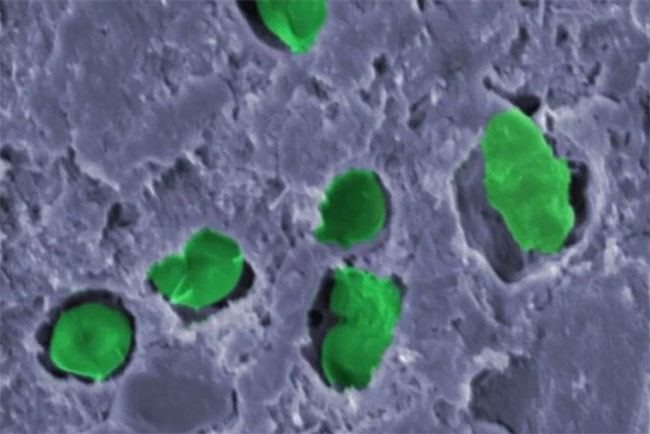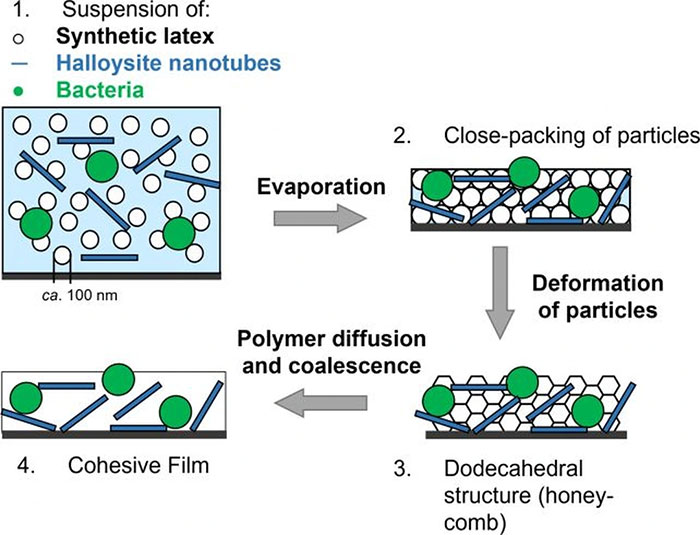New idea allows researchers to make oxygen on Mars
Researchers have successfully created a coating capable of generating oxygen and absorbing carbon dioxide, making it a potential candidate for Mars landing missions.
Chief among the challenges astronauts face in space is one of the body's most essential functions: breathing.

Microscopic image of bacteria hiding in a bio-coating. (Photo: University of Surrey).
That's because oxygen doesn't actually exist in space . This poses some problems for long-duration space missions. Fortunately, a recent discovery may give space explorers a leg up on their journey.
The results of a study led by microbiologist Simone Krings from the University of Surray, UK, have produced a bio-coating, called Chroococcidiopsis cubana .
This coating emits usable amounts of oxygen every day, while reducing the amount of carbon dioxide (CO 2 ) in the environment around it.
The coating's ability to produce oxygen comes from the living bacteria that are incorporated into each layer within it. But to be useful, the coating needs to be porous to allow for hydration and cell transport, but also mechanically strong and rigid.
This has implications not only for space missions, but can also have applications right here on Earth.

Diagram illustrating how a bio-based coating is made. (Photo: University of Surrey).
'With the increase in greenhouse gases, especially CO2 in the atmosphere, and concerns about water shortages due to rising global temperatures, we need sustainable, environmentally friendly materials ,' Simone Krings shared.
'Biocoatings with high mechanical strength can help address these challenges by reducing water consumption in water-intensive bioreactor-based processes.'
The key thing that makes Chroococcidiopsis cubana special is that it exploits a strange photosynthetic mechanism , which can make the most of extremely low light conditions, or even places with no light.
Because of this, other forms of Chroococcidiopsis cubana have been found in the darkness of extremely deep caves, in the Earth's lower crust, or on the ocean floor.
This material can sometimes survive in deserts and harsh environments not unlike those on Mars.

New idea could allow researchers to make oxygen on Mars. (Photo: Getty).
" Chroococcidiopsis has an extraordinary ability to survive in harsh environments, surviving drought and exposure to high levels of ultraviolet radiation ," said Simone Krings. "This makes them potential candidates for Mars landing missions."
However, it is not yet feasible to put Chroococcidiopsis into immediate use in space missions. This is because the production of this material is still quite low.
It is estimated that a group of 10 astronauts living on Mars for a year would consume about 500 tons of oxygen. Meanwhile, the biological coating is only capable of producing about 0.4 grams of oxygen per gram of biomass, equivalent to 400 grams per kilogram of material.
Thus, to ensure basic human respiratory activities in space, astronauts will have to carry a huge mass of Chroococcidiopsis, and this remains a difficult problem.
- Video: Mars has the ideal conditions to produce oxygen
- Evidence of Mars contains enough oxygen to support life
- Science has found a great solution to create oxygen right on Mars
- NASA detects oxygen in the Martian atmosphere
- Settling on Mars: Make water and oxygen
- Oxygen generator on Mars
- Mars soil could be used to 3D print rocket parts on the Red Planet
- US ambition to bring oxygen production to Mars
- NASA spacecraft discovered anomaly in oxygen on Mars
- NASA intends to create oxygen in the Martian atmosphere
- Mars once had an oxygen-rich atmosphere like the Earth
- Oxygen appears on Mars before Earth 1.5 billion years
 Announced 3 houses on the Moon and Mars
Announced 3 houses on the Moon and Mars Science proves: Mars also knows 'deflated'
Science proves: Mars also knows 'deflated' Elon Musk announced the price for a Mars trip was 11.6 billion VND, free of charge
Elon Musk announced the price for a Mars trip was 11.6 billion VND, free of charge NASA discovered strange 'gate' on Mars, is the hiding place found?
NASA discovered strange 'gate' on Mars, is the hiding place found?